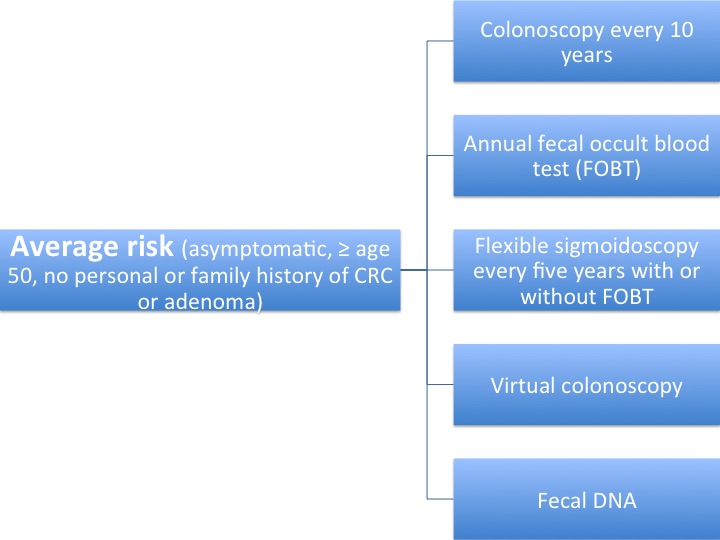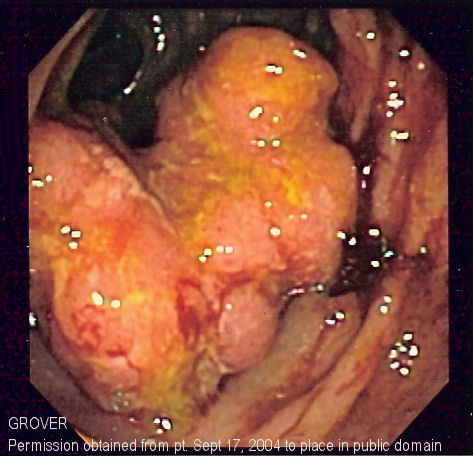Colorectal cancer screening: Difference between revisions
| Line 58: | Line 58: | ||
====Endoscopy==== | ====Endoscopy==== | ||
*A [[sigmoidoscopy|'''sigmoidoscopy''']] is a lighted probe ([[sigmoidoscope]]) that is inserted into the [[rectum]] and lower [[colon]] to check for [[polyps]] and other abnormalities | *A [[sigmoidoscopy|'''sigmoidoscopy''']] is a lighted probe ([[sigmoidoscope]]) that is inserted into the [[rectum]] and lower [[colon]] to check for [[polyps]] and other abnormalities.<ref name="pmid16635231" /> | ||
*A [[colonoscopy|'''colonoscopy''']] is a lighted probe ([[colonoscope]]) that is inserted into the [[rectum]] and the entire [[colon]] to look for [[polyp (medicine)|polyp]]s and other abnormalities that may be caused by [[cancer]]. A [[colonoscopy]] has the advantage that if [[polyp (medicine)|polyp]]s are found during the procedure they can be immediately removed, and the tissue can also be taken for [[biopsy]]. The [http://www.asge.org/ American Society for Gastrointestinal Endoscopy] has released quality indicators for screening [[colonoscopy]], which include:<ref name="pmid16635231">{{cite journal| author=Rex DK, Petrini JL, Baron TH, Chak A, Cohen J, Deal SE et al.| title=Quality indicators for colonoscopy. | journal=Am J Gastroenterol | year= 2006 | volume= 101 | issue= 4 | pages= 873-85 | pmid=16635231 | doi=10.1111/j.1572-0241.2006.00673.x | pmc= | url=http://www.ncbi.nlm.nih.gov/entrez/eutils/elink.fcgi?dbfrom=pubmed&tool=sumsearch.org/cite&retmode=ref&cmd=prlinks&id=16635231 }} </ref> | *A [[colonoscopy|'''colonoscopy''']] is a lighted probe ([[colonoscope]]) that is inserted into the [[rectum]] and the entire [[colon]] to look for [[polyp (medicine)|polyp]]s and other abnormalities that may be caused by [[cancer]]. A [[colonoscopy]] has the advantage that if [[polyp (medicine)|polyp]]s are found during the procedure they can be immediately removed, and the tissue can also be taken for [[biopsy]]. The [http://www.asge.org/ American Society for Gastrointestinal Endoscopy] has released quality indicators for screening [[colonoscopy]], which include:<ref name="pmid16635231">{{cite journal| author=Rex DK, Petrini JL, Baron TH, Chak A, Cohen J, Deal SE et al.| title=Quality indicators for colonoscopy. | journal=Am J Gastroenterol | year= 2006 | volume= 101 | issue= 4 | pages= 873-85 | pmid=16635231 | doi=10.1111/j.1572-0241.2006.00673.x | pmc= | url=http://www.ncbi.nlm.nih.gov/entrez/eutils/elink.fcgi?dbfrom=pubmed&tool=sumsearch.org/cite&retmode=ref&cmd=prlinks&id=16635231 }} </ref> | ||
:*Documentation of prep quality | :*Documentation of prep quality | ||
| Line 67: | Line 67: | ||
[[Image:Colorectal cancer endo 2.jpg|473x473px]] | [[Image:Colorectal cancer endo 2.jpg|473x473px]] | ||
==== | ==== CT colonography ==== | ||
:* | :* Also known as Virtual Colonoscopy | ||
:* | :* Requires special workstation software in order for the [[radiologist]] to interpret. | ||
:* This technique is approaching [[colonoscopy]] in sensitivity for [[polyps]] | |||
:* This technique is approaching [[colonoscopy]] in sensitivity for [[polyps]] | :* Any polyps found must still be removed by standard [[colonoscopy]] | ||
====Genetic Testing==== | ====Genetic Testing==== | ||
*[[Genetic counseling]] and [[genetic testing]] is a screening modality for families who may have a hereditary form of colon cancer, such as | *[[Genetic counseling]] and [[genetic testing]] is a screening modality for families who may have a hereditary form of colon cancer, such as: | ||
**[[hereditary nonpolyposis colorectal cancer]] (HNPCC) | **[[hereditary nonpolyposis colorectal cancer]] (HNPCC) | ||
**[[familial adenomatous polyposis]] (FAP) | **[[familial adenomatous polyposis]] (FAP) | ||
| Line 80: | Line 80: | ||
==== FIT-DNA testing ==== | ==== FIT-DNA testing ==== | ||
:* Multitargeted stool DNA testing | :* Multitargeted stool DNA testing | ||
:* | :* Combines: | ||
:** FIT | |||
:** cfcDNA methylation assays, in addition to fecal DNA that sheds into the stool from the cells of [[Precancerous|pre-malignant]] [[adenomas]] and [[cancers]] | |||
== References == | |||
{{Reflist|2}} | {{Reflist|2}} | ||
Revision as of 19:22, 28 January 2019
|
Colorectal cancer Microchapters |
|
Diagnosis |
|---|
|
Treatment |
|
Case Studies |
|
Colorectal cancer screening On the Web |
|
American Roentgen Ray Society Images of Colorectal cancer screening |
|
Risk calculators and risk factors for Colorectal cancer screening |
To view the screening of familial adenomatous polyposis (FAP), click here
To view the screening of hereditary nonpolyposis colorectal cancer (HNPCC), click here
Editor-In-Chief: C. Michael Gibson, M.S., M.D. [1] Associate Editor(s)-in-Chief: Elliot B. Tapper, M.D.; Saarah T. Alkhairy, M.D.
Overview
Current guidelines recommend that colonoscopy is the optimal screening tool for colon cancer since it detects 98-99% of the cases. High risk individuals include a first-degree relative with colorectal cancer. A colonoscopy every 10 years reduces the risk of left-sided colon cancer. Right sided colon cancers are more likely to be missed because they are harder to reach and they could be flat, which means they would be harder to detect. Flat growths (non-polypoid) are difficult to detect and are more likely to progress to colon cancer compared to cylindrical polyps.
Colorectal Cancer Screening
Early detection of premalignant colorectal masses or early-stage colorectal cancers is essential in treating these patients and possibly preventing cancer or colorectal cancer related death.
According to the USPSTF (United States Preventive Services Task Force):[1]
- Screening for colorectal cancer is recommended among adults older than 50 years of age and do not have an increased risk of developing the disease (average-risk adults).
- Decision to screen for colorectal cancer among adults aged 76 to 85 years is an individual one
- Screening would be more beneficial for healthier individuals that are able to undergo possible treatment
- Screening for colorectal cancer among adults aged 86 years and older is not recommended
- No preference is given to one screening modality over the other
- Decision should be shared and according to the patient's preferences when it comes to choosing an option
- Screening options:[1]
- Colonoscopy
- FIT
- Fecal immunochemical testing for occult blood
- Flexible sigmoidoscopy
- Flexible sigmoidoscopy + FIT
- CT colonography
- FIT-DNA
- multitargeted stool DNA testing
- gFOBT
- Guaiac-based fecal occult blood testing
Screening for colorectal cancer in individuals that are at increased risk of developing the disease is different and depends on several factors:[2][1]
- Family history of colorectal cancer before age 50
- Begin screening at an earlier age
- Risk of rapid disease progression
- Perform screening more frequently
- Family history of HNPCC or FAP
- Use most sensitive screening modality: colonoscopy
Screening protocols summarized in the figures below:



Types of Screening Methods
Fecal Occult Blood Testing
- A fecal occult blood test is a test for blood in the stool.
- There are two types of tests that can be used for detecting occult blood in stools:[1]
- FIT
- Fecal immunochemical testing for occult blood
- gFOBT
- Guaiac-based fecal occult blood testing
- FIT
- Use of low-sensitivity guaiac fecal tests is not recommended due to its of low sensitivity.[1]
Endoscopy
- A sigmoidoscopy is a lighted probe (sigmoidoscope) that is inserted into the rectum and lower colon to check for polyps and other abnormalities.[6]
- A colonoscopy is a lighted probe (colonoscope) that is inserted into the rectum and the entire colon to look for polyps and other abnormalities that may be caused by cancer. A colonoscopy has the advantage that if polyps are found during the procedure they can be immediately removed, and the tissue can also be taken for biopsy. The American Society for Gastrointestinal Endoscopy has released quality indicators for screening colonoscopy, which include:[6]
- Documentation of prep quality
- Photo documentation of cecal intubation
- Withdrawal time of 6 minutes or more
- Adenoma detection rate of greater than 25% in males and 15% in females greater than 50 years old
CT colonography
- Also known as Virtual Colonoscopy
- Requires special workstation software in order for the radiologist to interpret.
- This technique is approaching colonoscopy in sensitivity for polyps
- Any polyps found must still be removed by standard colonoscopy
Genetic Testing
- Genetic counseling and genetic testing is a screening modality for families who may have a hereditary form of colon cancer, such as:
FIT-DNA testing
- Multitargeted stool DNA testing
- Combines:
- FIT
- cfcDNA methylation assays, in addition to fecal DNA that sheds into the stool from the cells of pre-malignant adenomas and cancers
References
- ↑ 1.0 1.1 1.2 1.3 1.4 US Preventive Services Task Force. Bibbins-Domingo K, Grossman DC, Curry SJ, Davidson KW, Epling JW; et al. (2016). "Screening for Colorectal Cancer: US Preventive Services Task Force Recommendation Statement". JAMA. 315 (23): 2564–2575. doi:10.1001/jama.2016.5989. PMID 27304597.
- ↑ Lieberman, David A. (2009). "Screening for Colorectal Cancer". New England Journal of Medicine. 361 (12): 1179–1187. doi:10.1056/NEJMcp0902176. ISSN 0028-4793.
- ↑ https://www.rmf.harvard.edu/~/media/Files/_Global/KC/PDFs/RMFCRC.pdf
- ↑ https://www.rmf.harvard.edu/~/media/Files/_Global/KC/PDFs/RMFCRC.pdf
- ↑ https://www.rmf.harvard.edu/~/media/Files/_Global/KC/PDFs/RMFCRC.pdf
- ↑ 6.0 6.1 Rex DK, Petrini JL, Baron TH, Chak A, Cohen J, Deal SE; et al. (2006). "Quality indicators for colonoscopy". Am J Gastroenterol. 101 (4): 873–85. doi:10.1111/j.1572-0241.2006.00673.x. PMID 16635231.
